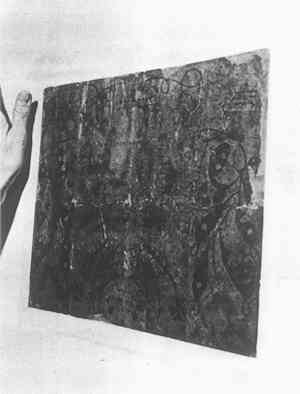THE CONSERVATION OF A SHENANDOAH VALLEY FRAKTURElizabeth C. Hollyday
6 LININGLying face down on a sheet of Japanese silk tissue on a clean, smooth, formica-top table, the fraktur was sprayed very lightly with water to relax it. Cockles and wrinkles were brushed out with a dampened Japanese water brush (Mizubake12 this brush is made of deer hair, as the catalog states; “the bristles are rounded at the time the brush is made in order to allow maximum control of the amount of water spread on the paper; when minimum water is required the brush is used in a horizontal position; the amount of water spread is increased as the brush is moved to a vertical position). With the Japanese pasting brush (Noribake—the bristle content of this brush is a combination of lamb and deer hair; it must be washed very carefully in cold water after each use), a thin coat of strained paste13 the consistency of light cream was brushed onto the rough side of a sheet of Uda paper, which was laid in the direction of the chain lines on the verso of the fraktur as backing, leaving a margin of one inch on all four sides, as shown in Figure 7. A slightly dampened smoothing brush (Uwabake—made of soft 100% lamb hair) was used to smooth the lining paper onto the verso of the fraktur. To assure the complete adhesion of the various papers, the smoothing brush was used to tamp the layers of paper, inserts, and mends together.
To remove creases, the fraktur was mounted on a drying panel of sanded, one-half inch thick plexiglass covered with Sekishu, medium Japanese mulberry paper, to approximate a Japanese drying screen, as shown in Figure 8. Before mounting the fraktur, the margins of the backing paper were coated with a thicker consistency of the wheat starch paste which held the dampened fraktur securely to the drying panel; as the paper gradually contracted while drying, the creases were pulled out. At this stage the fraktur was sized on the front by spraying it evenly with a 1/2% solution of gelatine. To keep the fraktur from tearing and
Removed from the drying panel, the fraktur was placed immediately between two 1/8 inch thick felts of fine weave,14 covered with plate glass, and weighted with 25 pounds for 24 hours. Some of the joins and inserts in the fraktur had opened while on the drying panel. After the 24 hours had expired, these were repasted from the front, and again the fraktur was placed between felts and weighted. Paint losses in the design were left untouched. Upon removal from the felts, the excess Japanese paper backing was trimmed with a scalpel. The Taufschein was hinged in a four-ply ragboard mount with the narrow window mat beneath the rabbet tinted to match the color of the paper of the fraktur.15 The Wythe County “wild turkey artist” Taufschein has been removed from the chest without significantly harming it.16 The tears and losses in the fraktur have been repaired; |

